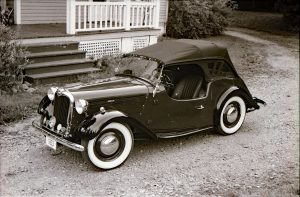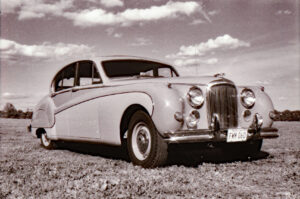History originally published in AutoWeek, February 13, 1984
Full square against the wind, it couldn’t be anything but British, tradition-proud and built in the time-honored way. More than a matter of appearance, an Alvis of the ‘30s is John Bull to the core, and the 4.3-liter tourer was the Alvis of Alvises.
A particularly British institution of the ‘30s the tourer was. An open car, it was more than a roadster – bigger, faster, and more expensive – and less than a convertible or drophead, without the roll-up windows and more careful weather sealing. The tourer made do with side curtains when the weather was foul, and with the folded-down windscreen whenever it wasn’t. It was how the “other half” roughed it, automotively speaking.
It was not a concept widely shared on the Continent where cabriolets, convertibles, and closed cars were more favored by the well-to-do. In America the tourer was virtually extinct and even in England it was a fading fancy. There were sufficient adherents to the style, however, that the British manufacturer of sporting automobiles couldn’t afford not to offer a tourer.
And of the British cars of the ‘30s, Alvis was among the finest, fully the peer of Bentley and Lagonda. A 4.3 saloon would top out over 100 mph, and Alvis claimed for it the title of the “fastest unsupercharged saloon on the British market” (a boast which seems contrived today but really wasn’t, considering the drive gear noise and added complication of vintage blowers). In tourer form it was even slightly faster.
But the sporting reputation of Alvis was based on more than the top speed of its saloons. The company raced all throughout the ‘20s, from the first cars it made, to the sophisticated dual overhead cam straight-eight front-wheel-drive cars the factory team raced on the Grand Prix circuit. Its victories were too often moral rather than outright, though. In addition, T.G. John, the founder, chairman and managing director, judged that the press didn’t give adequate coverage to automotive competition. As a result Alvis withdrew from racing after the 1930 Tourist Trophy race. Appropriately enough, the first Alvis finished fourth overall but first in class, first British car, and a “a mere 0.27 mph” off the pace of the 260cc larger Alfas finishing first through third. A moral victory, but a P.R. failure.
After abandoning racing, Alvis took a more direct approach to marketing. Its goal was to build a motorcar of prestige, real first cabin stuff. Not only would the more humble of the Alvis line (which weren’t all that humble) share in the reflected glory, but the luxury cars, in contrast to the racers, would do their share to fill the company coffers. The Alvis 3.5/Speed 25/4.3 series was the culmination of this approach. The 3.5-liter bowed in 1935 and was followed in 1936 by Speed 25, retaining the 3571cc displacement, and the 4.3 L, which was board out to an actual 4387cc. Otherwise, except for detail changes, the cars were the same.
Surprisingly enough for a series of coachbuilt automobiles, there was also significant similarity among most of the tourers. It’s the type of thing where two cars will seem identical until a side-by-side comparison reveals the differences – the shape of a wing, the cut of the door, the height of the windscreen.
This is true even of Alvis tourers body by different coachworks. The reason for the similarity is that, one, the radiators and bonnets with the same for marque identification and, two, that was simply what a British tourer was supposed to look like. Why the differences? Well, when they are individually handmade, why make them all the same? And, to be honest, there were some highly individual
Alvises.
If a single car can represent a series of coachbuilt automobiles – the 4.3s, like all Alvises, were all coachbuilt – perhaps it’s the 1938 tourer belonging to Zenon Bubnoski of Moorestown, New Jersey. The Cross & Ellis fabricated body looks like nothing so much as in up-scaled MG-TF with an extra set of doors, though actually the resemblance runs the other way. With the top up, it looks rakish; top-down, it’s sporty; windscreen down, it’s low and racy. Suit your mood.
With such classic British styling, one expects the ride and overall performance of what we’ve come to know as classic British sports car. Not so. This one is velvet, smooth as a centerfold’s derrière, a real sensory airbrushing. A basso profundo wogga-wogga-wogga from the exhaust is the only evidence of the reciprocating parts in the in-line OHV Alvis six.
What an engine. Undersquare even when bored out for the 4.3, it woggas out a maximum 137 bhp at 3600 RPM and is good to a 4500 RPM redline. To eliminate surge and enhance longevity, clustered valve springs were used, nine in a cage around each valve, alternating in coil direction to prevent stacking. It worked but it meant 108 valve springs in a six cylinder engine.
The remainder of the engine is equally robust, everything being webbed or reinforced or otherwise subject to vintage over-engineering. The extra-deep aluminum crankcase bolts to a rigid cast iron block. There are no water passages between block and head, coolant being routed through an aluminum transfer port at the rear of the engine. Finally, how could it be British without the three SU carbs?
Separated from the engine by a short shaft is the transmission, an Alvis masterpiece. It’s said to be the first all-synchro gearbox ever – beating even Rolls-Royce to the non-crunch—and in an era of crash boxes, it’s a revelation. Inside the beer keg casing the shafts are supported by not only end but also center bearings, and the transmission has its own oil pump. The synchronizer’s were an American design by General Motors, but were used on all four gears – because the gearbox designer was not adept at double clutching. Such are the origins of great ideas. The transmission was sturdy enough for armored car applications during World War II, but you would never guess from its fabulous silky operation. Modern transmissions should shift so well.
Ride and handling are equally impressive. A byproduct of the FWD racing cars was a ready adoption of independent front suspension on rear-wheel-drive Alvises. Lower radius arms on needle bearings are matched with an upper transverse spring with 11 leaves. At the rear, simple semi-elliptics were used but the axle was well-controlled. Alvis was never a proponent of the frame-as-a-spring school of engineering and that 4.3 is no exception. It’s massive down below and you can feel it. The car also feels remarkably balanced and cornering is smooth and flat, a sensation enhanced by the exceptional lowness of the car, even for today and especially for the era.
Details are what one would expect: on-board hydraulic jacking front and rear, automatic chassis lubrication, dashboard -controlled shocks front and rear. Brakes were cable-operated but servo-assisted. All steering linkage joints had lignum vitae – that’s wood—inserts for smooth (there’s that word again) feel.
The war brought an end to the production of the 4.3 at 198 cars. The Luftwaffe leveled the factory on November 14, 1940 and when automobile manufacture resumed after the war, it would a more conservative, lower-priced model line. The world had changed.
Alvis is little known in the US, largely because the company tended to the home market during its golden era. And anyway, only 42 of the 4.3’s are known to exist But as the Alvis eagle, flanked by the pizza-for-two sized headlights and riding the red triangle leads the 4.3 down the thoroughfare, there is no doubt that this is a classic. And thoroughly, most thoroughly British.

















I had the opportunity to procure a missing “Bladon” oil can – clipped to the firewall tray, along with other “must-have” tools on an Alvis recently. The car will attend Pebble Beach this year. Research is 98% of the acquisition. As it turns out, Diamond Bladon originally made “Petrol Blow-torches” for the lead-okra packing needed in the original “plumbing” trade. I do not know the final gasp of Diamond Bladon, however, the oil can in its final design for this car was a 2″ x 5″ cylinder with curved spout, mounted sideways on the scuttle. It used a trumpet valve for the thumb operated plunger pump, and, although many other designed “Aladdin’s Lamp” and Bicycle Dual -side Squeeze oil cans they made as well. I FOUND THE CORRECT ONE- in a antique shop in Australia! Research, research, and more research. We also copied it! Such is the world wide Snipe hunt that we enjoy daily. Actually, unlimited.
“Lead-okra”? You mean someone has found a worthwhile use for okra? Eating it certainly doesn’t qualify.